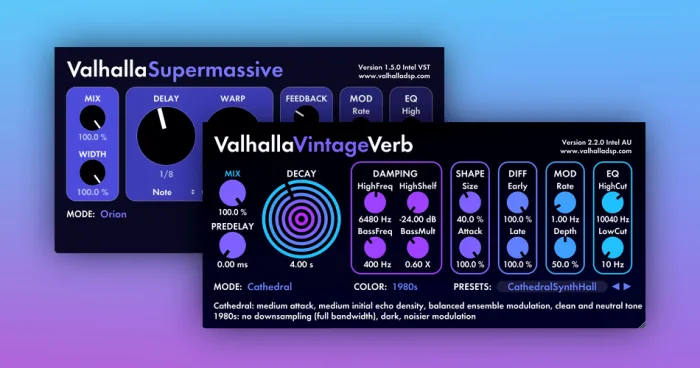Reverb is one of the most powerful tools in music production. It adds depth, atmosphere, and realism to your mix, helping sounds sit naturally in the sonic space. Whether you’re producing Drum and Bass, House, Techno, or any other genre, understanding how to use reverb effectively can take your tracks to the next level. In this guide, we’ll break down how reverb works, different types of reverb, and how to use it to create space in your music.
What is Reverb?
Reverb (short for reverberation) is the natural reflection of sound off surfaces in a space. When you clap your hands in a small room, the sound bounces off the walls and reaches your ears at slightly different times, creating a short, tight reverb. In a large hall, the sound reflections take longer to return, creating a longer, more spacious reverb tail.
In digital music production, reverb plugins simulate these reflections, allowing you to create a sense of space, depth, and movement in your mix.
Types of Reverb and When to Use Them
There are several types of reverb, each with its own character and best use cases:
1. Room Reverb
- Best for: Subtle, natural space on drums, vocals, and instruments.
- Sound: Short reflections that add presence without overwhelming the mix.
- Use case: Great for adding a live feel to close-miked recordings or electronic elements that sound too dry.
2. Hall Reverb
- Best for: Vocals, pads, synths, and cinematic effects.
- Sound: Long, lush tails that create a big, ambient space.
- Use case: Works well for atmospheric breakdowns in Drum and Bass, Techno pads, or ethereal vocals in House music.
3. Plate Reverb
- Best for: Vocals, snares, and lead instruments.
- Sound: Smooth, metallic, and slightly artificial, but very musical.
- Use case: Common in classic recordings for adding presence without too much space. A staple in House and Techno productions.
4. Spring Reverb
- Best for: Vintage-style sounds, guitars, and snares.
- Sound: Metallic, bouncy, and lo-fi.
- Use case: Often used in dub, reggae, and vintage electronic music to add character and energy.
5. Convolution Reverb
- Best for: Realistic room simulation, orchestral music, and live recordings.
- Sound: Uses impulse responses to capture real-world spaces.
- Use case: Great for creating ultra-realistic environments in film scoring or for adding organic space to electronic music.
How to Use Reverb to Create Space in Your Mix
1. Decide on the Size of the Space
Before applying reverb, think about the space you want to create. A tight, intimate mix might only need a short room reverb, while a deep, atmospheric track could benefit from a large hall reverb.
2. Use Reverb Sends Instead of Inserts
Instead of adding a reverb plugin directly onto every track, use a send/return channel. This method gives you more control over the reverb level and helps avoid a muddy mix.
3. EQ Your Reverb for Clarity
Reverb can quickly clutter your mix if not managed properly. Use an EQ to cut low-end frequencies from the reverb return (typically below 200Hz) to prevent a boomy mix. Rolling off some highs can also help keep the mix clean.
4. Use Pre-Delay to Maintain Clarity
Pre-delay controls the time between the dry sound and when the reverb starts. A short pre-delay (10-30ms) keeps things tight, while a longer pre-delay (50ms+) can help vocals and lead sounds stand out in the mix.
Another technique that’s particularly useful in fast tempo music like Drum and Bass is to sidechain the reverb signal to the input signal (the sound you adding reverb to). This keeps the sound present in the mix, while the reverb fills up the space after it.
5. Layer Different Reverbs
Combining multiple reverbs can create a more immersive sound. For example, a short room reverb on drums for tightness combined with a longer hall reverb on pads can give your track both clarity and depth.
6. Automate Reverb for Dynamic Movement
Instead of keeping the same reverb settings throughout the track, use automation to increase or decrease the reverb amount during different sections. For example:
- More reverb in breakdowns for atmosphere.
- Less reverb in drops for punch and impact.
- Automated reverb swells to transition between sections.
Common Mistakes to Avoid
- Too much reverb: Overloading your mix with reverb can make it sound washed out and muddy. Keep it subtle and intentional.
- Not tailoring reverb to the genre: A long hall reverb might work for ambient breakdowns but could ruin the punchiness of a Drum and Bass drop.
- Ignoring mono compatibility: Check your mix in mono to ensure the reverb doesn’t cause phase issues.
Final Thoughts
Reverb is an essential tool for creating space, depth, and emotion in your music. Whether you’re working on Drum and Bass, House, or Techno, understanding how to use different reverb types and techniques can transform your mix. Experiment, trust your ears, and use reverb to enhance – not overpower your productions.
Got a go-to reverb technique? Let us know in the comments!


